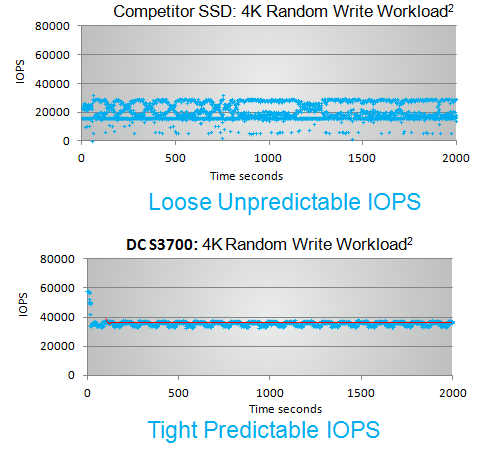Intel Launches DC S3700 SSD For Data Centers, Emphasizes Endurance and High Performance
Intel has announced a new series of SSDs aimed specifically at data centers, with a focus on features that matter most to that market. The DC S3700 series is designed to offer high performance at an extremely predictable rate, ensure end-to-end data protection, and keep total power consumption low.
Predictable performance in a data center is much more important than in the consumer or professional space. In normal workloads, it doesn't matter much if a series of drive operations is faster or slower, provided that the overall level of performance remains steady and the drop-offs aren't a sign of a deeper problem. Data centers, in contrast, absolutely require smooth operation. Performance of an entire disk array can crater if the controller is forced to spend time dealing with a handful of tasks that require a disproportionate amount of attention.

 Intel is claiming that the DC S3700 delivers a flat performance curve rather than bouncing back and forth across its potential IOP range. Error correction and security are two of the other major pillars of the drive's capability. One component of the drive's reliability is Intel's HET (High Endurance Technology).
Intel is claiming that the DC S3700 delivers a flat performance curve rather than bouncing back and forth across its potential IOP range. Error correction and security are two of the other major pillars of the drive's capability. One component of the drive's reliability is Intel's HET (High Endurance Technology).

HET improves NAND reliability in two basic ways. The first approach (detailed on the left-hand side of the image above) is that Intel cherry picks the best of its MLC NAND Flash for use in these drives. The benefit there is simple and straightforward -- by using the best chips it can build, Intel starts with a product that supports an inherently larger number of program/erase (P/E) cycles.

Intel hasn't released a new version of this slide with the DC S3700 charted, but it's safe to assume that the new drive is at least as capable as the 710 family. Longer read/write cycles improve drive endurance and extend the lifetime of the NAND flash. Intel's improvements to the DC S3700 may be even more aggressive; the company's literature claims that the SSD is designed to withstand being filled and erased 10x a day for five years. That comes out to 14.6 petabytes of data. The drive isn't drastically overprovisioned to hit that target; Intel told us the DC S3700 is overprovisioned at 20%. That's considerably more than your average consumer drive, but it's fairly modest for an enterprise product. Read/Write speeds are excellent; all drives are designed for up to 500MB/s reads, with writes betweenn 200MB/s on the 100GB drive, up to 460MB/s on the 800GB model.

The last bit of news out of this announcement is that Intel has returned to the SSD controller space; the DC S3700 has a custom Intel ASIC inside it. Some of you may remember that Intel initially took this route with its early SSDs, but it opted to use LSI's SandForce controllers for the more recent 300 and 500 products. The company has returned to its own silicon for the DC S3700, but hasn't said when, or if, the new chip will make it into consumer hardware. Depending on where Intel focused its efforts, there may not be much call for it, consumer SSDs wouldn't necessarily benefit from Intel HET or the enterprise-grade data protection algorithms the DC S3700 incorporates.
Predictable performance in a data center is much more important than in the consumer or professional space. In normal workloads, it doesn't matter much if a series of drive operations is faster or slower, provided that the overall level of performance remains steady and the drop-offs aren't a sign of a deeper problem. Data centers, in contrast, absolutely require smooth operation. Performance of an entire disk array can crater if the controller is forced to spend time dealing with a handful of tasks that require a disproportionate amount of attention.



HET improves NAND reliability in two basic ways. The first approach (detailed on the left-hand side of the image above) is that Intel cherry picks the best of its MLC NAND Flash for use in these drives. The benefit there is simple and straightforward -- by using the best chips it can build, Intel starts with a product that supports an inherently larger number of program/erase (P/E) cycles.


The last bit of news out of this announcement is that Intel has returned to the SSD controller space; the DC S3700 has a custom Intel ASIC inside it. Some of you may remember that Intel initially took this route with its early SSDs, but it opted to use LSI's SandForce controllers for the more recent 300 and 500 products. The company has returned to its own silicon for the DC S3700, but hasn't said when, or if, the new chip will make it into consumer hardware. Depending on where Intel focused its efforts, there may not be much call for it, consumer SSDs wouldn't necessarily benefit from Intel HET or the enterprise-grade data protection algorithms the DC S3700 incorporates.

